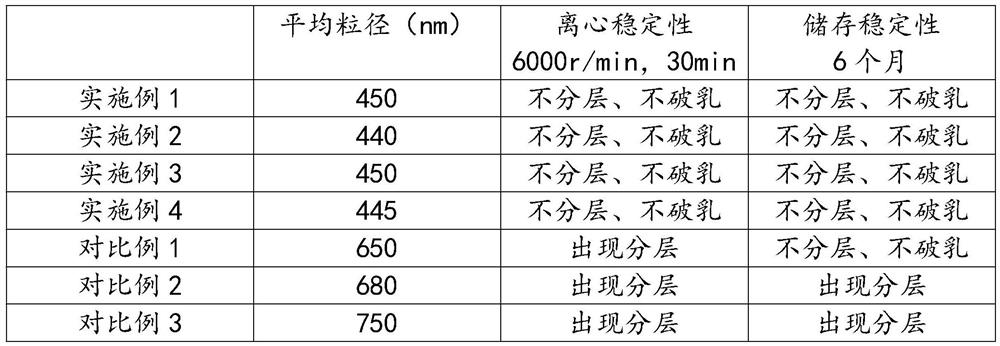Preparation method of graphene-based waterborne epoxy resin emulsion
A water-based epoxy resin and epoxy resin technology, applied in the field of preparation of water-based epoxy resin emulsion, can solve the problems of storage stability and application performance, large particle size, etc.
- Summary
- Abstract
- Description
- Claims
- Application Information
AI Technical Summary
Problems solved by technology
Method used
Image
Examples
Embodiment 1
[0030] A preparation method based on graphene-based aqueous epoxy resin emulsion, comprising the steps:
[0031] The first step, weigh the following raw materials in parts by weight: 10 parts of modified graphene, 3 parts of emulsifier, 35 parts of epoxy resin, 5 parts of polyethylene glycol, 120 parts of propylene glycol methyl ether, 20 parts of deionized water, 1 part Boron trifluoride, 1 part GSK-550;
[0032] Step 2: Add epoxy resin to a beaker filled with propylene glycol methyl ether, heat in a water bath at 60°C and stir at a constant speed until a transparent solution is formed, then add emulsifier and polyethylene glycol, and continue stirring for 30 minutes;
[0033] Step 3: Add boron trifluoride and modified graphene, cool down to 30°C and stir at a constant speed for 10 minutes, then raise the temperature to 85°C, react at this temperature for 2 hours, then cool down to 60°C, add deionized water dropwise, and control The dropping time is 1h, stirring at a constant ...
Embodiment 2
[0043] A preparation method based on graphene-based aqueous epoxy resin emulsion, comprising the steps:
[0044] The first step, weigh the following raw materials by weight: 12 parts of modified graphene, 4 parts of emulsifier, 40 parts of epoxy resin, 8 parts of polyethylene glycol, 130 parts of propylene glycol methyl ether, 22 parts of deionized water, 1 part Boron trifluoride, 2 parts GSK-550;
[0045] Step 2: Add epoxy resin to a beaker filled with propylene glycol methyl ether, heat in a water bath at 60°C and stir at a constant speed until a transparent solution is formed, then add emulsifier and polyethylene glycol, and continue stirring for 30 minutes;
[0046] Step 3: Add boron trifluoride and modified graphene, cool down to 30°C and stir at a constant speed for 10 minutes, then raise the temperature to 85°C, react at this temperature for 2 hours, then cool down to 60°C, add deionized water dropwise, and control The dropping time is 1h, stirring at a constant speed ...
Embodiment 3
[0049] A preparation method based on graphene-based aqueous epoxy resin emulsion, comprising the steps:
[0050] The first step, weigh the following raw materials by weight: 14 parts of modified graphene, 4 parts of emulsifier, 45 parts of epoxy resin, 8 parts of polyethylene glycol, 140 parts of propylene glycol methyl ether, 28 parts of deionized water, 2 parts Boron trifluoride, 2 parts GSK-550;
[0051] Step 2: Add epoxy resin to a beaker filled with propylene glycol methyl ether, heat in a water bath at 60°C and stir at a constant speed until a transparent solution is formed, then add emulsifier and polyethylene glycol, and continue stirring for 30 minutes;
[0052] Step 3: Add boron trifluoride and modified graphene, cool down to 30°C and stir at a constant speed for 10 minutes, then raise the temperature to 85°C, react at this temperature for 2 hours, then cool down to 60°C, add deionized water dropwise, and control The dropping time is 1h, stirring at a constant speed...
PUM
 Login to View More
Login to View More Abstract
Description
Claims
Application Information
 Login to View More
Login to View More - R&D
- Intellectual Property
- Life Sciences
- Materials
- Tech Scout
- Unparalleled Data Quality
- Higher Quality Content
- 60% Fewer Hallucinations
Browse by: Latest US Patents, China's latest patents, Technical Efficacy Thesaurus, Application Domain, Technology Topic, Popular Technical Reports.
© 2025 PatSnap. All rights reserved.Legal|Privacy policy|Modern Slavery Act Transparency Statement|Sitemap|About US| Contact US: help@patsnap.com

